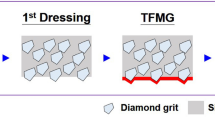Abstract
We demonstrate the possibility of the crack-free laser dicing of borosilicate glass. The effect of a polymer layer is analyzed on the laser (diode-pumped solid-state, 355 nm, nanosecond) dicing capability of a commercial glass (Borofloat®33) for backend packaging. The main drawbacks concerned the brittleness of glass and photothermal ablation which induces thermal stresses responsible for chipping or cracks. It was assumed that a thick enough polymer would enhance the energy coupling between the beam and the target. The effect of pulse energy and speed on the scribing depth is provided in the present article. A numerical simulation using COMSOL® Multiphysics was performed in order to analyze the volume temperature distribution. It revealed that the temperature remained higher than the working point of glass (1,500 K) between two pulses. The viscosity is thus low between two pulses, and thermal stresses are diminished compared to the processing of raw glass samples.















Similar content being viewed by others
References
A.K. Dubey, V. Yadava, J. Mater. Process. Technol. 195, 15–26 (2008)
S. Nisar, L. Li, M.A. Sheikh, J. Laser Appl. 25, 042010 (2013)
D. Ashkenasi, M. Schwagmeier, SPIE Conf. Proc. 6458, 64580F.1–64580F.8 (2007)
S. Nikumb et al., Thin Solid Films 477, 216–221 (2005)
Y. Izawa, S. Tanaka, H. Kikuchi, Y. Tsurumi, N. Miyanaga, N. Esashi, M. Fujita, Debris-free in-air laser dicing for multi-layer MEMS by perforated internal transformation and thermally-induced crack propagation. in IEEE 21st International Conference on Micro Electro Mechanical Systems, MEMS 2008 (IEEE, Tucson, AZ, 2008), pp. 822–827
J.-Y. Cheng et al., J. Micromech. Microeng. 16, 2420–2424 (2006)
P. Lorenz, M. Ehrhardt, K. Zimmer, Appl. Surf. Sci. 258, 9138–9142 (2012)
K. Sugioka et al., Appl. Phys. A 77, 251–257 (2003)
K. Cvecek et al., Phys. Procedia 5, 495–502 (2010)
A. Salleo, T. Sands, F.Y. Génin, Appl. Phys. A 71, 601–608 (2000)
G. Savriama, J. Mendez, L. Barreau, C. Boulmer-Leborgne, N. Semmar, J. Laser Appl. 25, 052010–052016 (2013)
M.P. Groover, Fundamentals of Modern Manufacturing: Materials, Processes and Systems, 4th edn. (Wiley, USA, 2010), p. 258
S.M. Eaton, H. Zhang, P.R. Herman, Opt. Express 13, 4708–4716 (2005)
D.J. Garibotti, US Patent 3,112,850, 3 Dec 1963
H. Fujishiro et al., Jpn. J. Appl. Phys. 36, 5633–5637 (1997)
B.C. Stuart et al., Phys. Rev. B 53, 1749–1761 (1996)
E.G. Gamaly, A.V. Rode, B. Luther-Davies, V.T. Tikhonchuk, Phys. Plasmas 9, 949 (2002)
X. Liu et al., IEEE J. Quantum Electron. 33, 1706–1717 (1997)
C.W. Ponader, J.F. Schroeder, A.M. Streltsov, J. Appl. Phys. 103, 063516-1–063516-5 (2008)
L. Bessel et al., J. Non-Cryst. Solids 357, 2367–2640 (2011)
J.B. Lonzaga et al., J. Appl. Phys. 94, 4332–4340 (2003)
G. Savriama, V. Jarry, L. Barreau, C. Boulmer-Leborgne, N. Semmar, Appl. Surf. Sci. 302, 163–168 (2014)
P. Schaff, Laser processing of materials: Fundamentals, applications and development, (Springer series in materials science 139, 2011), pp. 32–33
X. Liu, W. Yu, Res. J. Text. Apparel 10, 26–32 (2006)
X. Zhang, P.Z. Cong, M. Fujii, Int. J. Thermophys. 27, 880–895 (2006)
J. Han et al., Appl. Surf. Sci. 256, 6649–6654 (2010)
I. Miyamoto, K. Cvecek, M. Schmidt, Opt. Express 21, 14291–14302 (2013)
D.M. Karnakis, M.R.H. Martyn, T. Kevin, M. Schlaf, H.V. Snelling, Proc. SPIE 5718, 216–227 (2005)
A.N. Samant, N.B. Dahotre, Int. J. Tools Manuf. 48, 1345–1353 (2008)
S. Juodkazis, H. Misawa, I. Maksimovb, Appl. Phys. Lett. 85, 5239–5241 (2004)
Acknowledgments
The authors would like to acknowledge J. Mendéz for providing the glass samples.
Author information
Authors and Affiliations
Corresponding author
Rights and permissions
About this article
Cite this article
Savriama, G., Semmar, N., Barreau, L. et al. Experimental and numerical analysis of crack-free DPSS laser dicing of borosilicate glass. Appl. Phys. A 119, 559–569 (2015). https://doi.org/10.1007/s00339-015-8991-9
Received:
Accepted:
Published:
Issue Date:
DOI: https://doi.org/10.1007/s00339-015-8991-9




